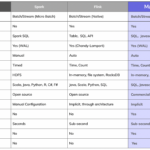Amazon, the e-commerce giant, has revolutionized the way businesses use Big Data for gaining valuable customer insights. Leveraging its massive database of customer behavior, preferences, and purchases, Amazon has harnessed the power of data analytics to personalize user experiences, optimize inventory management, and drive targeted marketing campaigns. By analyzing vast amounts of data in real-time, Amazon can anticipate customer needs, recommend products, and enhance overall satisfaction. This proactive approach to data utilization underscores Amazon’s commitment to leveraging Big Data for a better understanding of customers and ultimately boosting business success.
In the modern digital landscape, Amazon stands as a titan in the realm of e-commerce, leveraging the power of big data to gain profound insights into customer behavior, preferences, and trends. This approach not only enhances customer experiences but also reinforces Amazon’s market dominance. Below, we will explore the various strategies employed by Amazon to harness big data for actionable customer insights.
Understanding Big Data in E-commerce
Big data refers to vast volumes of structured and unstructured data generated from diverse sources. In the context of e-commerce, this includes customer interactions, purchase histories, browsing patterns, reviews, social media activity, and more. Amazon utilizes advanced analytics and algorithms to sift through this data, turning it into meaningful insights that drive decision-making.
Data Collection Techniques
Amazon employs several robust data collection techniques that help in acquiring a comprehensive understanding of its customers. Primarily, these include:
- Customer Behavior Tracking: Amazon tracks user interactions on its platform, noting everything from click-through rates to shopping cart abandonment. This data captures real-time consumer behavior.
- Purchase History Analysis: By analyzing past purchasing data, Amazon identifies trends and preferences, helping it suggest relevant products to consumers.
- Feedback and Reviews: Customer reviews and ratings provide valuable data on product performance and customer satisfaction, allowing Amazon to improve services and offerings.
- Social Media Monitoring: By analyzing sentiments on social platforms, Amazon can gauge customer perceptions and preferences.
Advanced Analytics Techniques
Once data is collected, Amazon employs various advanced analytics techniques to derive insights:
- Predictive Analytics: Amazon uses predictive analytics to forecast future customer behaviors based on historical data, enabling them to optimize marketing strategies and inventory management.
- Machine Learning: Algorithms learn from data patterns over time, improving the accuracy of product recommendations and personalization efforts.
- Sentiment Analysis: By analyzing customer reviews and feedback using natural language processing, Amazon can assess customer sentiment and improve product listings and descriptions.
Personalization of Customer Experience
One of the most impactful applications of big data at Amazon is in the personalization of the shopping experience. By leveraging customer data, Amazon tailors the shopping experience in several ways:
- Product Recommendations: Amazon’s algorithm suggests products based on users’ browsing and purchase history. This personalized approach is instrumental in increasing conversion rates.
- Dynamic Pricing: Amazon employs big data to adjust prices in real-time based on demand, competition, and customer preferences, ensuring competitive pricing strategies.
- Email Campaigns: Amazon sends targeted emails to users based on their past behavior and preferences, promoting products that they are likely to purchase.
Enhancing Customer Engagement
Amazon uses data to enhance customer engagement through various strategies:
- Content Customization: By analyzing user behavior, Amazon customizes the content displayed on the homepage, ensuring that customers find products and offers most relevant to them.
- Amazon Prime Recommendations: Through big data analytics, Amazon identifies which products might encourage customers to subscribe to Amazon Prime, further enhancing their service offerings.
- Retention Strategies: By analyzing churn rates and behaviors, Amazon can implement targeted retention strategies, such as personalized discounts or exclusive offers for frequent shoppers.
Inventory Management and Supply Chain Optimization
Big data analytics not only helps in understanding customers but also plays a crucial role in inventory management and supply chain optimization:
- Demand Forecasting: Amazon uses historical sales data, market analysis, and economic indicators to accurately forecast product demand, which reduces excess inventory and stockouts.
- Warehousing Efficiency: Data analytics informs Amazon about optimal storage solutions, shelf placements, and routing for faster delivery times, enhancing operational efficiency.
- Supplier Performance Monitoring: By evaluating supplier metrics, Amazon can streamline its supply chain, ensuring high product availability and reducing costs.
Customer Service Improvements
Amazon invests heavily in analytical tools to boost its customer service through:
- Chatbots and Virtual Assistants: Utilizing machine learning, Amazon’s customer service chatbots can resolve common queries, freeing up human agents for more complex issues.
- Data-Driven Support Insights: By analyzing customer interactions, Amazon identifies recurring issues, enabling them to refine FAQs and support resources effectively.
Privacy and Data Security Considerations
While the benefits of using big data are immense, Amazon also places a strong emphasis on data privacy and security:
- Data Encryption: Sensitive customer data is encrypted to prevent unauthorized access, ensuring privacy and compliance with regulations.
- Transparency Measures: Amazon maintains open communication about data usage practices, allowing customers to manage their privacy preferences effectively.
The Future of Big Data at Amazon
As technology evolves, so too will Amazon’s strategies for leveraging big data. Future advancements may include:
- Enhanced AI Implementation: Continued development in artificial intelligence will further refine algorithms and predictions, improving customer insights.
- Expanded Use of IoT Devices: Integration of the Internet of Things (IoT) could provide Amazon with even richer data sources from smart devices to enhance customer experiences.
- Real-Time Data Analysis: As technology improves, real-time analytics will allow Amazon to respond to customer needs instantaneously, offering unparalleled service.
The diverse and innovative ways in which Amazon harnesses the power of big data for customer insights not only propel its competitive edge but also set a benchmark for other businesses in the e-commerce sector. By continually evolving its data strategies, Amazon exemplifies the importance of big data in enhancing customer experience, ensuring operational efficiency, and driving overall business success.
Amazon leverages Big Data analytics to gain valuable customer insights that drive personalization, operational efficiency, and business growth. By harnessing the power of data, Amazon continuously enhances customer experiences, optimizes product recommendations, and makes data-driven decisions to stay ahead in today’s competitive market landscape.














